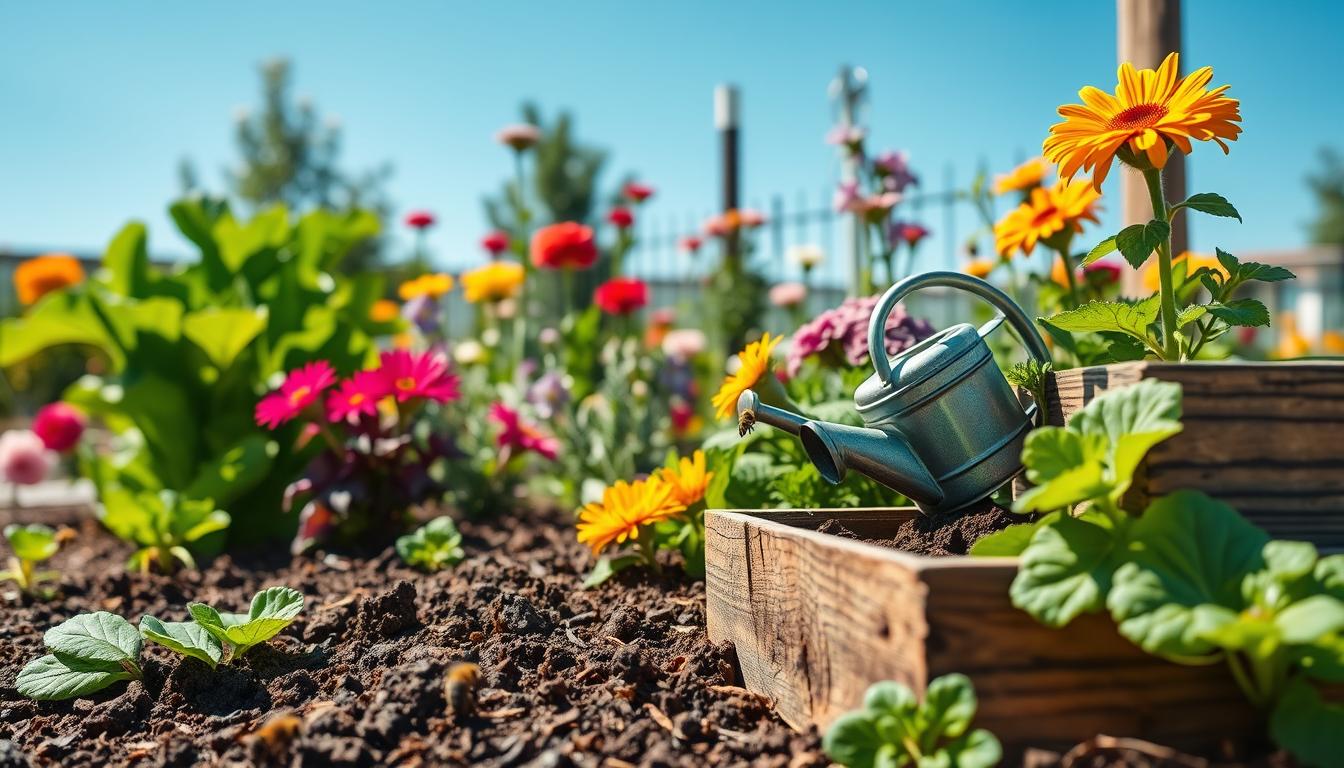I’m excited to share my personal experience with organic gardening. I’ve learned 5 proven tips to grow a lush and healthy garden. These tips use organic gardening tips and natural gardening techniques. My goal is to inspire and educate readers on the benefits of sustainable gardening practices.
Through my journey, I’ve learned the importance of choosing the right plants and building healthy soil. Managing pests naturally is also key. By following these tips and adopting sustainable gardening practices, readers can create a thriving garden. This garden not only benefits the environment but also gives a sense of accomplishment and pride.
Understanding Organic Gardening
Organic gardening is more than just growing plants. It’s about creating a balanced ecosystem. I’ve learned to use natural fertilizers and pesticides instead of synthetic ones. This has made my plants healthier and helped the environment.
Learning about organic gardening has taught me to care for my garden’s soil, plants, and ecosystem. My garden now attracts more birds, bees, and beneficial insects. This is thanks to the organic approach.
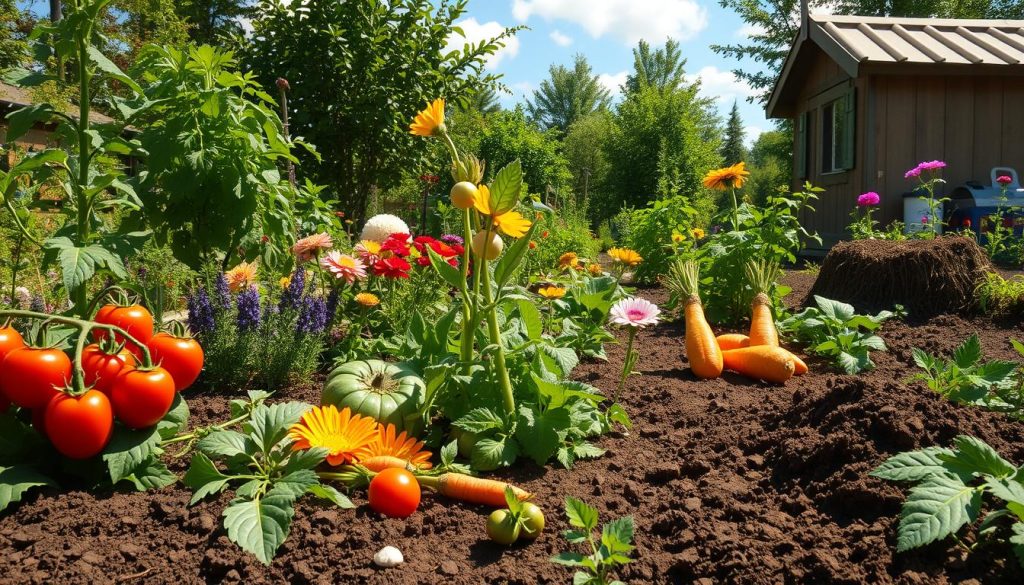
What is Organic Gardening?
Organic gardening uses natural materials and techniques to grow plants. It avoids synthetic fertilizers and pesticides. Instead, it uses compost and manure.
Benefits of Going Organic
Organic gardening has many benefits. These include:
- Improved soil health
- Increased biodiversity
- Reduced environmental impact
- Healthier plants and produce
By following organic gardening tips, I’ve made my garden sustainable. It benefits my family and the environment.
Tip 1: Choose the Right Plants for Your Climate
When starting organic gardening, picking the right plants is key. This is where eco-friendly gardening tips help. By choosing plants that fit your area, you use less pesticides and chemicals.
To begin, look up local plants that do well in your climate. Think about temperature, rainfall, and soil type. You can also talk to local nurseries, gardening clubs, or extension offices for advice.
Research Local Plant Varieties
- Look for plants that are native to your region, as they will be more resistant to local pests and diseases.
- Check the USDA Plant Hardiness Zone Map to determine which plants are suitable for your area.
- Read reviews and ask for recommendations from other gardeners in your area.
Consider Native Plants
Native plants are great for organic gardening. They need little care and attract local pollinators and wildlife. This helps create a balanced ecosystem.
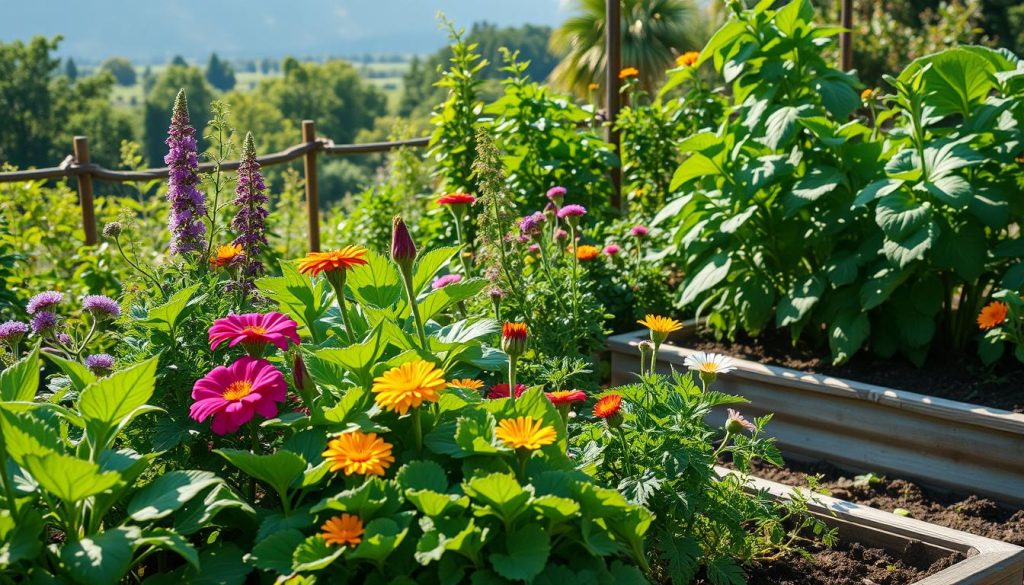
By following these tips, you can have a thriving, sustainable garden. It’s good for the environment and your community. Always choose organic gardening and eco-friendly tips for a healthy garden.
Tip 2: Build Healthy Soil
Building healthy soil is key to a successful organic garden. Healthy soil helps plants grow well. By using natural gardening methods, like composting, we can make our soil better. This means we don’t need to use harmful fertilizers.
Compost is very important for soil health. It’s full of nutrients that make soil better. Making your own compost at home is a great way to help the environment. Here’s how to make compost:
- Collect kitchen scraps, like fruit and vegetable peels, and add them to your compost pile
- Include yard trimmings, like leaves and grass clippings, to add carbon-rich materials to your compost
- Turn your compost pile regularly to ensure it gets enough oxygen and breaks down evenly
After making compost, test your soil to see its pH level and nutrient content. This tells you what your soil needs. By following these tips, you can make your soil healthy for your plants.
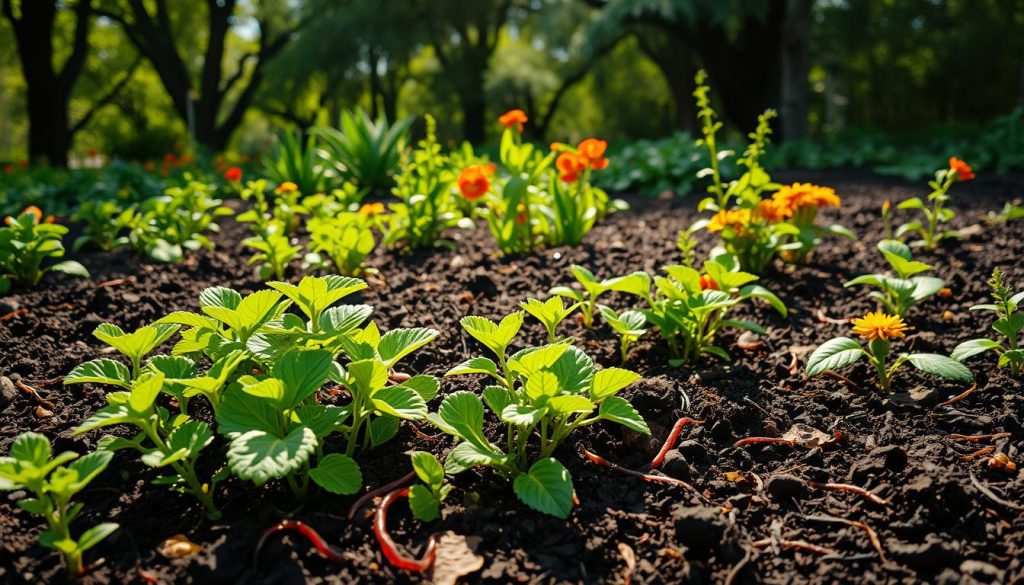
By making your soil healthy, you’ll have a garden full of life and color. Keep following these tips to make your garden even better.
| Soil Type | pH Level | Nutrient Content |
|---|---|---|
| Clay | 6.0-7.0 | High in nutrients, but prone to waterlogging |
| Sandy | 6.0-7.0 | Low in nutrients, but well-draining |
| Loam | 6.0-7.0 | Balanced nutrient content and good drainage |
Tip 3: Embrace Companion Planting
As I delve into sustainable gardening, I’ve found the joy of companion planting. It’s about pairing plants to boost growth, fight pests, and increase harvests. This method helps gardeners build a greener, more balanced garden.
Companion planting works by matching plants that help or hinder each other. For instance, marigolds with tomatoes can keep nematodes away, which harm tomatoes. It’s a key part of eco-friendly gardening.
What is Companion Planting?
Companion planting is a simple yet powerful way to help plants grow well. By picking the right plant pairs, gardeners can cut down on harmful chemicals. This makes gardening kinder to the planet.
Examples of Effective Pairings
Some great pairings include:
- Planting basil with tomatoes to improve flavor and repel pests
- Pairing beans with corn to provide support and enhance growth
- Combining marigolds with carrots to deter nematodes and other pests
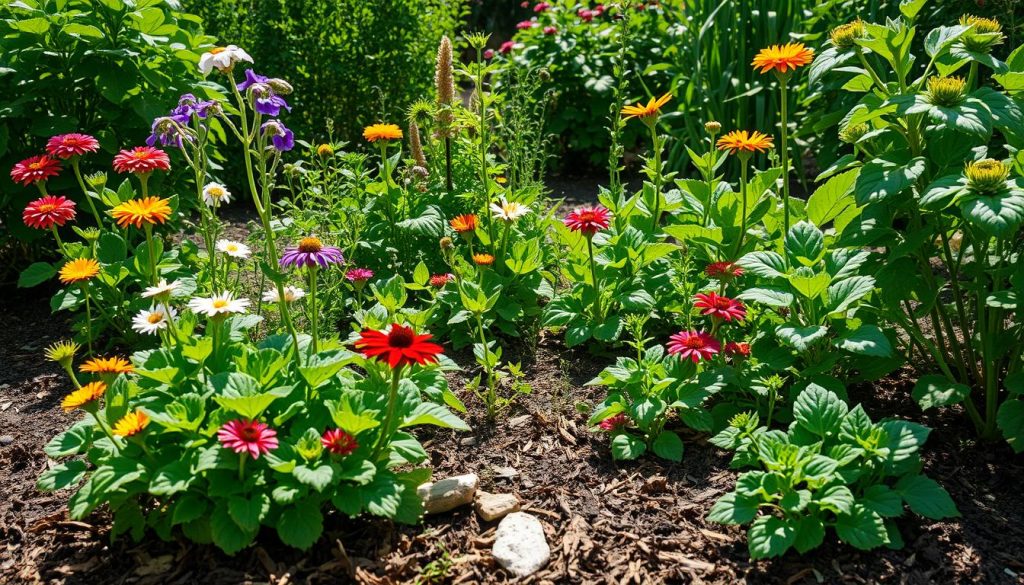
By using companion planting, gardeners can make their gardens more sustainable. This method is a big part of eco-friendly gardening. It helps create a healthier, more balanced garden ecosystem.
Tip 4: Manage Pests Naturally
As I explore organic gardening, I’ve found that managing pests naturally is key. Using organic methods and tips helps me avoid harsh chemicals. This way, my garden stays healthy and balanced.
Identifying common pests is a big step. Pests like aphids, whiteflies, and spider mites can harm plants. Spotting them early helps me protect my garden and cut down on pesticide use.
Identify Common Garden Pests
Some common pests include:
- Aphids: small, soft-bodied insects that feed on plant sap
- Whiteflies: tiny, winged insects that feed on plant sap and can transmit diseases
- Spider mites: tiny, spider-like insects that feed on plant sap and can cause yellowing leaves
Natural Pest Control Methods
To keep pests away naturally, I use several methods. I introduce beneficial insects like ladybugs and lacewings. I also use neem oil to repel pests.
Good garden hygiene is another key. I remove weeds and debris to stop pests from spreading. These steps help me maintain a balanced and healthy garden.
Tip 5: Water Wisely
Watering wisely is key in organic gardening. It helps plants grow well and saves water. Always check the soil moisture before watering.
Here are some best practices for watering:
- Check soil moisture by inserting your finger into the soil up to the knuckle
- Use drip irrigation to deliver water directly to the roots
- Avoid overwatering, which can lead to root rot and other problems
By following these tips, you can make your garden thrive. Water when the soil feels dry. Also, avoid getting water on leaves to prevent diseases.
When to Water Your Plants
The best time to water depends on the climate and soil. Water in the morning or early afternoon. This allows plants to absorb water all day. Use these tips to grow a beautiful, healthy garden.
| Soil Type | Watering Frequency |
|---|---|
| Clay soil | Less frequently, as clay soil retains water well |
| Sandy soil | More frequently, as sandy soil drains quickly |
| Loamy soil | Moderately, as loamy soil balances water retention and drainage |
Seasonal Organic Gardening Tips
As I explore organic gardening, I’ve learned the value of adjusting to each season. By using sustainable gardening methods, my garden thrives all year. Here, I’ll share tips for getting your garden ready for spring and fall.
In spring, start seeds indoors and get the soil ready. Add compost and organic matter to enrich the soil. Good spring plants include broccoli, kale, and spinach.
Spring Planting Tips
- Start seeds indoors 4-6 weeks before the last frost date
- Prepare the soil by adding compost and other organic matter
- Plant cool-season crops like broccoli, kale, and spinach
In fall, clean up your garden and get it ready for next year. Remove dead plants, add compost, and plant cover crops. This stops erosion and adds nutrients to the soil.
Fall Preparation Techniques
- Clean up the garden by removing dead or dying plants
- Add compost to the soil to replenish nutrients
- Plant cover crops like clover or rye to prevent erosion
Follow these tips for a thriving, sustainable garden. You’ll get fresh produce all year. Always choose organic and sustainable gardening for a healthy garden and environment.
| Season | Task | Benefits |
|---|---|---|
| Spring | Start seeds indoors | Early start on the growing season |
| Spring | Prepare the soil | Improved soil health and fertility |
| Fall | Clean up the garden | Reduced risk of disease and pests |
| Fall | Plant cover crops | Prevention of erosion and soil replenishment |
Tools and Resources for Organic Gardening
As I explore organic gardening, I’ve learned the value of the right tools and resources. Eco-friendly gardening advice has helped me grow a garden that’s good for my family and the planet. Here, I’ll share some key tools and resources that have been crucial for me.
For organic gardening, having the right tools is essential. You’ll need gloves, pruning shears, and a watering can. These tools make tasks like planting, pruning, and watering easier, keeping your garden healthy and vibrant.
Recommended Tools and Resources
- Gloves: protect your hands from thorns and dirt
- Pruning shears: help with pruning and trimming plants
- Watering can: gentle on plants and helps with efficient watering
- Organic gardening books: provide valuable information and inspiration
- Online gardening communities: connect with other gardeners and share knowledge
Online resources have also been very helpful. Sites like the National Gardening Association and the Organic Gardening Association offer lots of info. They cover topics like soil health, composting, and natural pest control.
By following eco-friendly gardening advice and using the right tools and resources, you can create a beautiful and sustainable garden. Choose tools and resources that match your values and goals. And don’t hesitate to join online communities for support and advice.
| Tool/Resource | Description |
|---|---|
| Gloves | Protect your hands from thorns and dirt |
| Pruning shears | Help with pruning and trimming plants |
| Watering can | Gentle on plants and helps with efficient watering |
Common Mistakes to Avoid
As I share organic gardening tips, I stress avoiding common mistakes. These can harm your plants and the environment. Natural gardening techniques help create a healthy, sustainable garden. It’s crucial to watch out for pitfalls that can slow your progress.
Some common mistakes to avoid include:
- Overwatering, which can lead to root rot and other problems
- Using chemical fertilizers, which can contaminate the soil and harm beneficial microorganisms
Overwatering and Its Effects
Overwatering is a big mistake that can hurt your plants. To avoid it, check the soil moisture often. Water only when needed to prevent waterlogged soil and root rot.
Using Chemical Fertilizers
Chemical fertilizers might seem like a quick fix for growth. But they harm the environment in the long run. Choose natural gardening methods like compost or manure to enrich the soil. This boosts soil fertility and supports local ecosystems.
My Journey in Organic Gardening
Looking back, organic gardening has been incredibly rewarding. I began with a few raised beds and now have a lush oasis. It feeds my family and helps the local ecosystem. I’ve learned a lot about soil, plants, and natural pest control.
What I Learned Along the Way
Patience and persistence are key in organic gardening. It takes time, effort, and a willingness to try new things. I’ve had both successes and failures, but each taught me something about nature’s balance.
Tips for Beginners
For beginners, start small and be patient. Enjoy the journey, even with mistakes. Seek out gardening communities for support. With time and effort, you’ll create a garden that’s good for you and the planet.

